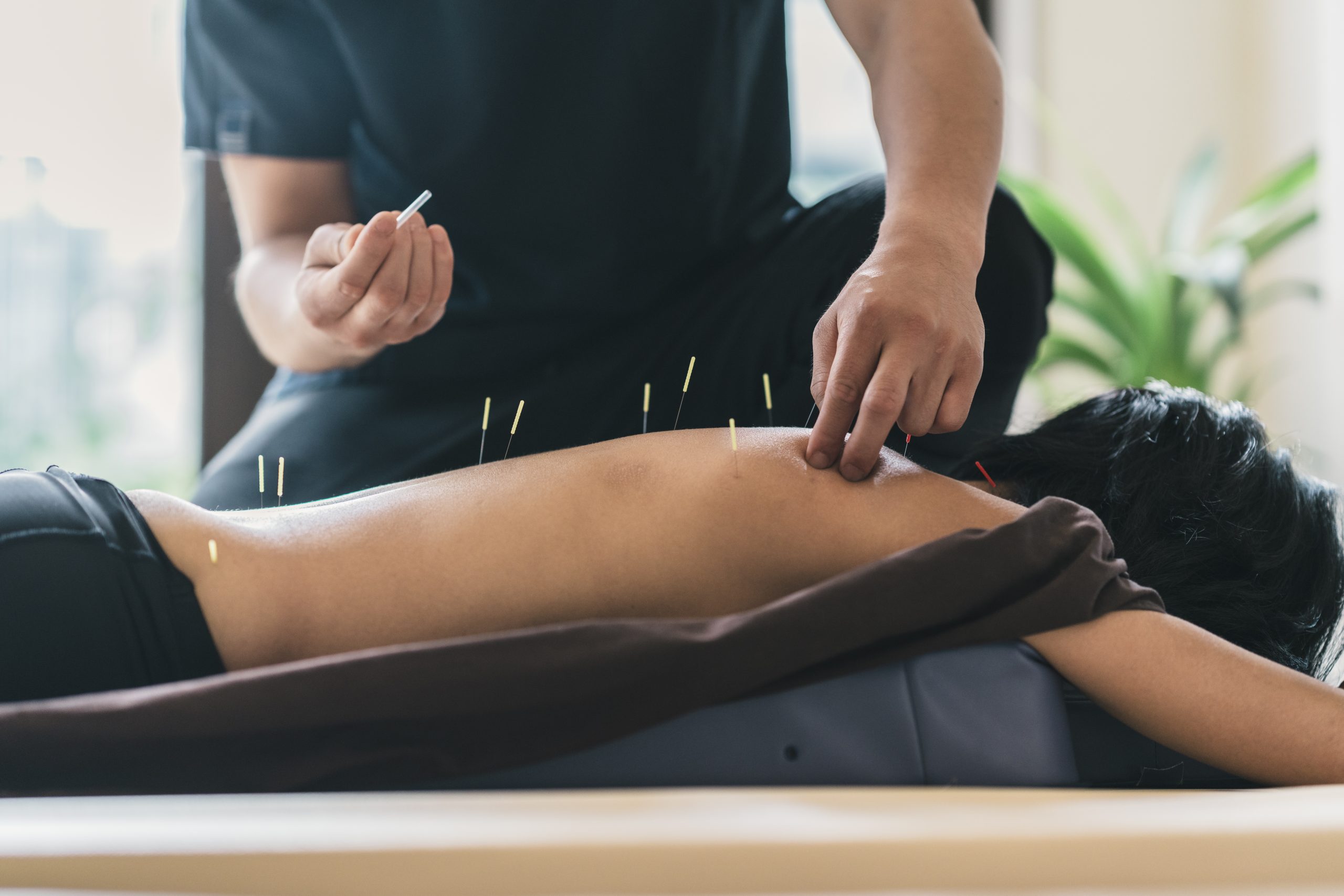Pain Management

Acute and Chronic Pain Management
Acupuncture is becoming increasingly popular as an alternative treatment for a wide variety of pain. This includes both acute and chronic, and of a musculoskeletal or neurological nature. Some of the most common symptoms that patients will seek relief from are neck, back, and neuropathy pain. Acupuncture is a safe, non-invasive method of relieving pain and works by stimulating certain points on the body with needles to promote a healing response in the body. Acupuncture can help reduce inflammation, improve circulation and reduce muscular tension. Additionally, acupuncture can help to reduce pain by releasing natural pain-relieving hormones, such as endorphins.
Studies have shown that acupuncture is an effective treatment for chronic neck and back pain in both the short-term and long-term. A meta-analysis of randomized clinical trials concluded that acupuncture may be beneficial in reducing neuropathic pain . These studies demonstrate that acupuncture is a safe and effective therapy for neck, back, and neuropathic pain. Acupuncture can be used as a complementary or alternative treatment to other pain management treatments. It may also be beneficial in the holistic treatment of neck, back, and neuropathy pain. By taking a comprehensive approach to pain management, acupuncture can help reduce the need for more invasive treatments.
Acupuncture is also successful in treating:
- Knee pain
- Golfers and tennis elbow
- Ankle Sprains and Strains
- Migraines and Generalized Headaches
- Fibromyalgia
- Carpal Tunnel
- Other Pain Conditions
Pain Management of the Neck

Neck pain can be a symptom of many underlying causes and is a common complaint seen in primary care practice. Commonly reported sources of neck pain include posture-related issues, disc herniation, muscular strain, arthritis, whiplash injury and migraines.
Posture-related neck pain is the most common source of neck pain. It is often associated with keeping the head in an unsupported posture for long periods of time, such as looking down at a computer screen or phone. This causes tension and strain on the muscles and ligaments of the neck, leading to painful symptoms.
Disc herniation is a frequent source of neck pain. Discs act as cushions between vertebrae, providing shock absorption and support; however, when these discs become damaged they may protrude into the spinal canal causing pain by compressing nerves and other structures within it. This type of neck pain is typically localized to one specific area but can radiate down into the arms and hands if not managed properly.
Migraines can also cause neck pain, as well as neck issues can be the cause of some migraines. Migraines are intense headaches that can cause one-sided throbbing pain in the head and neck, as well as associated nausea, light sensitivity and other symptoms. Neck pain may be a symptom of an impending or active migraine episode, and some people with migraines experience neck pain without an accompanying headache.
Acupuncture For Neck Pain
Acupuncture is a holistic treatment approach for the relief of neck pain. It uses electric stimulation and neuromodulation to help reduce muscle tension, which can contribute to discomfort in the neck area. Acupuncturists insert needles into specific points on the body, called acupuncture points. These needles are then stimulated with electric current or pressure from the hands. The stimulation helps reduce muscle tension and spasms, promotes blood flow and oxygenation, and helps to release endorphins (the body’s natural painkillers).
Studies have indicated that acupuncture may be a helpful alternative for those seeking relief from chronic neck pain. A review of 11 studies found evidence that acupuncture could provide short-term relief from acute neck pain when compared to sham treatment or no treatment at all. Another study showed that combining electric stimulation with traditional treatments (such as physiotherapy) was more effective than traditional treatments alone for relieving chronic neck pain over a six-month period.
It is important to note that many factors such as posture, lifestyle choices and underlying health conditions will affect how well acupuncture works for any individual person with neck pain; what works for one person may not always work for another person even if they have similar symptoms. Working with an experienced acupuncturist who understands your case history can help get you the best results possible from your treatment plan.
Pain Management of the Low Back
Back pain is a common and debilitating condition that can be caused by a number of factors, including poor posture, disc herniation, spinal stenosis, and other muscular-skeletal conditions. Poor posture is a frequent cause of back pain, as it puts an unnatural strain on the spine that can lead to neck and back pain. Disc herniation, which occurs when a disc between two vertebrae ruptures or bulges out of place, is another common cause of back pain. Spinal stenosis, an abnormal narrowing of the spinal canal, can also lead to severe pain in the back and extremities.
It is important to identify the underlying cause of any back pain in order to properly treat it. Treatment for back pain may involve medications, physical therapy, and in many cases, using acupuncture will speed up healing and can be used independently of other treatments. Regular exercise and proper posture can help reduce the risk of developing chronic back pain. It is important to reach out to a medical professional if you have experienced any prolonged or severe back pain in order to identify the cause and obtain appropriate treatment as necessary.
Acupuncture for Low Back Pain
Acupuncture is a form of traditional Chinese medicine that involves the insertion of thin needles into specific points on the body to promote healing and reduce pain. Acupuncture has been used for centuries to treat various types of pain, including low back pain, and modern research has found acupuncture treatments to be effective in reducing chronic low back pain.
Studies suggest electroacupuncture can be beneficial for treating low back pain by stimulating nerve fibers located around the spine. This electrostimulation helps to modulate sensory input, which can influence muscle tone and local inflammation levels. Through electroacupuncture neuromodulation, practitioners are able to reduce both acute and chronic pain and improve overall function in patients with low back pain.
In addition, electroacupuncture treatments are typically well-tolerated, with few side effects. This makes electroacupuncture a safe and effective treatment option for those suffering from low back pain. Overall, electroacupuncture is an excellent option for treating low back pain due to its ability to reduce pain, improve overall function and do so without the risk of serious side effects.

Pain Management With Peripheral Neuropathy
Peripheral neuropathy is a disorder of the peripheral nervous system, which includes all of the nerves that extend from the brain and spinal cord to other parts of the body. It is a common problem affecting up to 8% of people over 55 years old in America. Peripheral neuropathy can be caused by a variety of potential medical conditions, including diabetes, autoimmune diseases, tumors, viral infections, trauma, and certain medications. In some cases, the cause may be unknown.
The most common symptoms associated with peripheral neuropathy are numbness or decreased sensation in the hands and feet; tingling or burning sensations; numbness or decreased motor function in the hands and feet; and pain that ranges from mild to severe. These symptoms will vary depending on what type of nerve has been damaged. For example, if sensory nerves have been affected by peripheral neuropathy then numbness and tingling sensations may be more prominent than motor function loss or pain.
In diabetic peripheral neuropathy (DPN), numbness typically begins in a stocking-glove pattern on both sides of the body starting with the toes and working its way up towards the torso. Other common locations for numbness associated with peripheral neuropathy include hands, arms, legs and even face muscles in some cases. Painful sensations such as burning or stabbing sensation are commonly reported among those suffering from DPN due to nerve damage caused by high blood glucose levels over time. In addition to numbness or decreased sensation, sufferers may also experience decreased muscle strength which can lead to difficulty walking and maintaining balance when standing up or walking on uneven surfaces.
Peripheral neuropathy is typically diagnosed based on physical examination results combined with medical history information and electrical tests like electromyography (EMG) which measure electrical activity in your muscles and nerves. Treatment options vary depending on underlying causes but often involve managing underlying conditions such as diabetes while providing medications to help control pain such as antidepressants, anticonvulsants or opioids if needed. Physical therapy can be helpful for those who have lost muscle strength due to nerve damage while lifestyle modifications such as avoiding alcohol can help reduce risk factors for developing DPN over time.
Acupuncture in The Treatment Of Peripheral Neuropathy
Acupuncture and electroacupuncture is a great option for those with peripheral neuropathy, as it can help reduce inflammation and provide relief from symptoms. The World Health Organization states that acupuncture has been found to be effective in treating a variety of conditions including peripheral neuropathy. Acupuncture has the ability to stimulate the nerves and improves circulation and nerve function. Additionally adding acupuncture, and in some cases, herbal medicine will help manage your specific cause of peripheral neuropathy. With proper care and treatment, many people with peripheral neuropathy are able to manage their symptoms successfully. There is no single treatment for peripheral neuropathy, so it’s important to work with your acupuncturist and/or other healthcare provider to find the best options for you.
Pain Management Of Migraines
Migraines are a type of headache that can cause severe throbbing or pulsing pain, usually on one side of the head. These headaches are often accompanied by other symptoms, such as nausea and sensitivity to light and sound. Migraine attacks can last from a few hours to several days and can occur frequently in some people. While there is no known exact cause, migraines are thought to be linked to blood flow and muscle imbalance changes in the brain, as well as certain auras, or warning signs that can precede an attack.
The blood vessels surrounding the brain may play a role in migraine attacks. During an attack, blood vessels may enlarge due to inflammation caused by the release of various chemicals from nerve fibers that wrap around blood vessels in the brain. This process, called neurogenic inflammation, causes blood vessels to widen (dilate) and become more sensitive than normal. Blood vessel widening can stimulate nerve fibers that cause pain signals to be sent to the brainstem — where they are perceived as head pain.

Imbalances in certain chemicals within the brain may also be involved in causing migraines. For example, serotonin is a chemical produced by nerve cells that helps regulate pain signals sent from other parts of your body to your brain. Low levels of serotonin can cause changes in blood vessels, triggering a migraine headache. Other substances related to migraine headaches include substance P (which transmits pain signals from your nerve endings to your brain), CGRP (calcitonin gene-related peptide), dopamine and noradrenaline (both hormones).
In some people with migraine headaches, changes in blood flow or muscle tension start before their actual headache begins – this is referred to as an aura which could include flashes of light or blind spots, tingling sensations on one side of their face or body or difficulty speaking clearly for example. Auras usually start 10–30 minutes before a headache begins and can last for up to an hour afterward but not everyone experiences an aura with their migraine attack.
Ultimately though it is still unclear what triggers these biochemical reactions which bring about migraines. Environmental factors such as stress, anxiety and depression have been found to increase the risk, while particular foods like chocolate and alcohol have also been associated with higher chances of getting migraines. It’s important for those who experience frequent attacks to keep track of any potential triggers they notice during episodes so they can manage them better going forward.
Traditional Chinese Medicine To Treat Migraines
Acupuncture and herbal medicine have been used to successfully treat migraines for centuries. Acupuncture is a form of traditional Chinese medicine that involves the insertion of thin needles into specific points of the body to release energy and relieve pain. Herbal medicines are derived from herbal plants, roots, and leaves, which are believed to provide therapeutic benefits. The combination of acupuncture and herbal medicine has been found to be an effective remedy for treating migraines by reducing inflammation, promoting blood circulation, and calming nerve impulses.
To start treatment, the practitioner will assess the patient’s medical history and conduct a physical examination. During this process, the practitioner may use special diagnostic tools such as tongue and pulse diagnosis to assess any underlying conditions or imbalances within the body that may be contributing to migraine symptoms. Each migraine patient has a unique pattern, so treatments for migraine patients vary widely.
Once these factors have been evaluated, the patient will likely begin acupuncture treatments at least once per week for several weeks or until they begin feeling relief from their migraine symptoms. Depending on the patient’s condition and health goals, herbal medicines may also be prescribed as supplemental treatments during this time period in order to further reduce inflammation and provide additional comfort from discomfort associated with migraine attacks.
